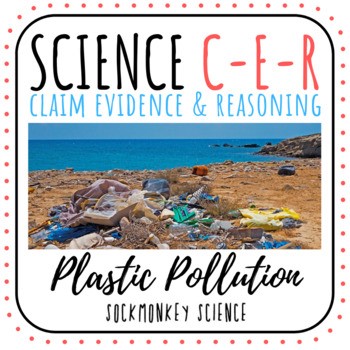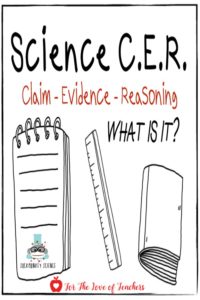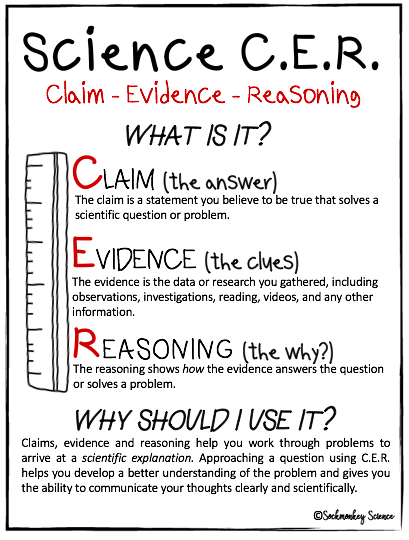
Guest Post Written By Sockmonkey Science
Science comes naturally to most elementary students. After all, observing phenomena and problem solving is the way their young minds develop. However, I notice that although my students are able to tackle big issues and come up with creative solutions, they have difficulty articulating their conclusions scientifically. They can’t tell me WHY or HOW. Justifying their work logically is a huge part of what they should be learning in my class, but it always seems to be the area we are most lacking in.
For a long time, I tried following the scientific method to help students explain their thought processes. However, the steps aren’t always clear and also seem to vary from publisher to publisher, causing confusion for students (and teachers) as they advance to higher grade levels. Recently, I stumbled across the Claim, Evidence, Reasoning (CER) model, and I feel like this simple graphic organizer based approach is something that will really help my students write scientifically and prepare them for more rigorous lab reports in high school.
What is CER?
CER is a writing strategy that helps students analyze information and experiences in an organized, concise manner. The process for elementary students usually starts with a question or prompt from the teacher relating to a scientific concept they are familiar with. The students then use the CER method to answer the question (or make a claim) providing both evidence and reasoning. Seems simple, right? That’s because it is! Well, it should be, anyway. Students generally have NO problem making a claim, or even stringing together some evidence to support it, but when it comes to providing the reasoning that connects the claim and evidence students tend to freeze up.
CER Poster
The good news is with proper introduction, scaffolding, and practice, CER should dramatically improve your students’ scientific reasoning and writing skills. The GREAT news is that you can turn almost anything into a CER moment. In fact, many educators suggest introducing the concept with something that ISN’T science-related.
One of the best examples I have seen of this comes from Trevor Register, who shows an Audi television commercial, “My Dad’s an Alien” to introduce using CER. The commercial shows a young girl listing the evidence of why she believes her father is an alien, and students must decide for themselves if he is indeed an alien. The commercial is pretty straightforward, and the content leads to some thought-provoking and creative discussion from students.
OK, OK…That’s great, but how do you use this with actual scientific concepts you are teaching?
Here is an example.
Juan brought his lunch to school in a brown paper bag. Once he has finished, there is nothing left in the bag. However, his friend Mia disagrees. She believes the bag contains air. Who is correct?
So, this option leaves two ways to use CER. The first option is to simply provide students with a data table showing the physical properties of the bag (like mass and volume) when it is full of lunch as opposed to when it is only full of air. The second option, which I prefer, would allow students to conduct the investigation and gather the data. Have students measure the mass of the bag when it is full of lunch, when it is open and empty, as well as when it is inflated with air and closed. Then allow them to make a claim based on their own data, and provide the evidence and reasoning to substantiate their claim!
If you aren’t sure how to start incorporating CER into YOUR classroom, Model Teaching has a great article, checklist, and graphic organizer available to download free here.
I have also started creating some CER prompts to tackle real-world science issues! Check it out!

If you like this post, you may like these:
Teaching Science with Art: Animal Adaptations for Kids
Science Vocabulary: Why Is It So Important?
About the Author: Mary is the mother of two amazing little boys. When she is not changing diapers, she is mom blogging, teaching elementary science and creating science resources to share with other teachers. She will complete her M. Ed. later this year, and hopes to become a school counselor in the near future! You can find her on Sockmonkey Science, TPT, Facebook, Instagram, and Pinterest, and even subscribe to her blog by email for some cool surprise freebies!
If you like it, then pin it!

Thanks for reading!


Christine Weis is a passionate educator, classroom management coach, wife, and mom of two busy boys. She enjoys teaching, writing, and creating resources for teachers.






This is useful for students and teachers. Being able to understand how to make interactive lessons that deal with reasoning helps students retain what they learn.
Yes! Absolutely! Thanks for reading!
Christine at For The Love of Teachers
This is useful for students and teachers. Being able to understand how to make interactive lessons that deal with reasoning helps students retain what they learn.
Making students use their minds to for reasoning is a great way to lead them to success in the future!
I agree! It’s so important! Thank you for reading!
Christine at For The Love of Teachers
Yes! It sure does! Thanks for reading!
Christine at For The Love of Teachers
Super interesting way to challenge and learn! Loved reading this post
I agree! Thank you so much! Glad you liked the post!
Thanks for reading!
Christine at For The Love of Teachers
Helping students express their thought process in general and in science requires great skill and benefits them greatly. You are an asset!
Thank you so much! 🙂
Christine at For The Love of Teachers
Helping students express their thought process in general and in science requires great skill and benefits them greatly. You are an asset!
Hhhhhmmmmm….I love the sound of this model. Only one thing is left….to try it out on my end and share some feedback!
That’s right! Testing it and getting feedback is an essential part of any process. Thanks for reading!
Christine at For The Love of Teachers
We were taught to think in a manner like this when I was in high school. Regarding the bag, both are right LOL.
Yes! Both are right! Thanks for reading!
Christine at For The Love of Teachers
Claim Evidence Reasoning sounds a bit technical for kids but I know it will be a good way for them to dissect information and know more about things in the world. I hope that this can be taught in all schools.
Me too! We must challenge their thinking as early as the elementary grades. Critical thinking at its best! Thanks for reading!
Christine at For The Love of Teachers
I think anyone who writes, no matter how old, can definitely benefit from this. I’ve been writing for a long time, and I still sometimes have trouble getting everything organized.
I completely agree! This is an excellent model for all ages when writing and thinking critically. Thanks for reading!
Christine at For The Love of Teachers
I want to introduce this strategy to my kids, in hopes that they will use it in their science class. It seems like a really easy process to learn.
This is an awesome way to challenge students to use their minds to work through their answer. I hope to see this take off in schools across the country
I think so too. Challenging students to think and write critically is such an important skill to practice. Thanks for reading!
Christine at For The Love of Teachers